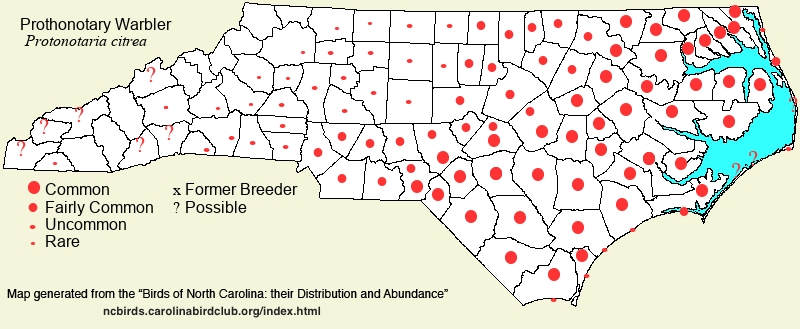 |  |
|
Prothonotary Warbler - Protonotaria citrea PARULIDAE Members: | Search Common: Search Scientific: |
|
|
|||||||
| General Comments | The Prothonotary Warbler has often been called the "Golden Swamp Warbler", with good reason -- the male's bright golden head and breast often glow amid the dark green color of its swampy habitat. This is a bird of the Deep South, breeding barely north to New York and southern Ontario. In North Carolina, it is truly a common bird of Coastal Plain swamps, but is much less numerous farther inland, and was apparently absent in the mountains as a breeder until the early 2020s. It inhabits swamps, bottomlands, nonriverine forests, wooded beaver ponds, and other wet habitats with some dead trees and stubs for nesting (in existing) cavities. Because its habitat actually appears to be increasing in the East, owing to an increase in beavers and beaver ponds, the Prothonotary Warbler appears to be slightly increasing, as well. | ||||||
| Breeding Status | Breeder | ||||||
| NC BRC List | Definitive | ||||||
| State Status | |||||||
| U.S. Status | |||||||
| State Rank | S5B | ||||||
| Global Rank | G5 | ||||||
| Coastal Plain | Summer resident. Breeds over the entire province, even sparingly on the Outer Banks. Common to very common in most areas, especially numerous in wide swamps and bottomlands -- both in blackwater and in brownwater river systems. One of the most common of birds nesting in swamps. Mainly early Apr to early Sep. Peak counts: 105, Alligator River NWR (Dare), 1 Jun 2015. | ||||||
| Piedmont | Summer resident. Fairly common in the eastern and southern portions of the region, especially around the margins of Jordan and Falls lakes. Uncommon in the central portions, and very rare to rare in the western third, mainly restricted to larger floodplains and margins of lakes. Presumably nests inland at least sporadically west to Lake James (Burke) and Lake Adger (Polk) (confirmed nest in 2014), but likely absent from a few counties. The inner edge of the breeding range needs more elucidation, especially as most western portion reports are one-time sightings only. Mainly early Apr to late Aug; rare after early Sep. Peak counts: | ||||||
| Mountains | Scarce transient, and now almost certainly a very rare and local breeder. Rare transient in spring, and very rare in fall. In early summer, a handful of reports at very low elevations, mainly below 2,000 feet. An adult seen carrying food at the Biltmore Estate (Buncombe) in Jun 2024 strongly suggests nesting there. In addition, one singing in southern Clay on 8 Jun 2024 was at a suitable place and elevation (below 2,000 feet) for breeding. One singing at Murphy (Cherokee) on 16 Apr 2024 was notable, as a potential breeder. Mostly mid-Apr into May, and mid-Aug to mid-Sep. Peak counts: | ||||||
| Finding Tips |
The species is impossible to miss along Coastal Plain rivers in the breeding season. Good areas are Howell Woods preserve in Johnston, or Lumber River SP, but stopping at most bridge crossings over wooded creeks will suffice. **** | ||||||
| Attribution | LeGrand[2024-11-08], LeGrand[2024-08-06], LeGrand[2023-08-10] | ||||||
| NC Map Map depicts all counties with a report (transient or resident) for the species. | Click on county for list of all known species. |
| NC Breeding Season Map Map depicts assumed breeding season abundance for the species. |  |